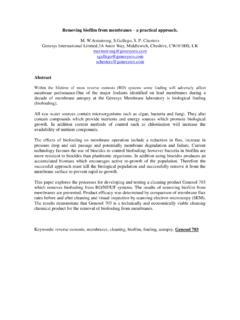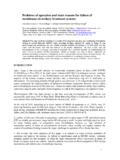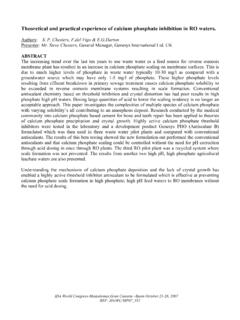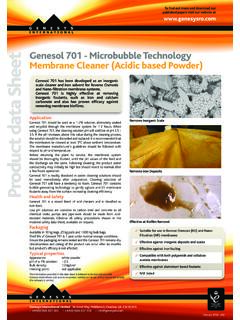Transcription of A STUDY OF THE PHYSICAL AND CHEMICAL DAMAGE ON …
1 The International Desalination Association World Congress on Desalination and Water Reuse 2013 / Tianjin, China REF: IDAWC/TIAN13-184 A STUDY OF THE PHYSICAL AND CHEMICAL DAMAGE ON REVERSE OSMOSIS MEMBRANES DETECTED BY AUTOPSIES Authors: Nuria Pe a Garc aa, Fernando del Vigoa Stephen Chestersb, Matthew Armstrongb, Rachel Wilsonb, Max Fazelb a Genesys Membrane Products, C/Londres 38, Oficina 204, Las Rozas, 28232, Madrid, Spain b Genesys International Ltd., 3A Aston Way, Middlewich, CW10 OHS, Cheshire, UK Presenter: Nuria Pe a Garc a Laboratory Manager Genesys Membrane Products Spain Abstract Water treatment by reverse osmosis technology has as main aim to reject the maximum percentage of ions from raw water, giving as much treated water flow as possible.
2 When there is a loss in these two parameters performance, it is essential to find the source of the failure, in order to use the necessary tools for its recovery. At this point, membrane autopsies are a very valuable source of information in order to understand the mechanisms that may have produced membrane capabilities loss. Genesys Membrane Products (GMP) laboratory has developed during last decade more than 600 autopsies of membranes from all over the world. Therefore all the data obtained from these autopsies are a very valuable source of information about membrane failures. These membranes studies have shown that in almost the 75% of the cases, fouling is the main cause of membrane failures and this is one of the reasons because there is a broad research developed in fouling mechanisms understanding.
3 The data obtained from these autopsies, have demonstrated also that the worst and main impact of fouling on membranes performance is the DAMAGE of polyamide layer and on rejection capabilities (1). During the performance of reverse osmosis membranes in plants, there are many different processes that can DAMAGE the membrane surface: increases in differential pressure, backpressure phenomena, abrasion processes from fouling, massive or micro damages from scaling, oxidation processes or even degradation with time or cleanings. These damages, are commonly related to an increase in flow rate permeate and in a salt rejection decrease. A well knowledge of membrane DAMAGE is very important considering that in more than the 30% of the membranes autopsied in GMP this phenomenon was found severe.
4 These phenomena STUDY is important also because, in many cases, DAMAGE is hidden by fouling and autopsies are the only way to detect a first step DAMAGE that could be prevented in plant if appropriated remedies are applied. GMP autopsies results demonstrate that almost the 80% of the studied membranes show slight signals of DAMAGE on the membrane surface, which were probably not detected in plant considering only performance failures. In this STUDY , statistical analysis from autopsies data will be used to check membrane damages, considering plants performance, membrane position, kind of fouling, feed water type, etc. From the results obtained during the autopsies carried out on GMP laboratory and some preliminary tests carried out with some new techniques, the author intends to do also a review of the different analytical tools available for membrane damages detection and to check their advantages and disadvantages.
5 The International Desalination Association (IDA) World Congress on Desalination and Water Reuse REF: IDAWC/TIAN13-184 -- 2 -- I. INTRODUCTION Treatment of water by reversed osmosis is nowadays a well known and broadly used technology that still needs much research on new composite compositions and STUDY in order to avoid membrane lacks and failures. Membrane autopsies are one of the main tools for the determination of membrane failures and for getting an accurate identification of membrane fouling. All the different steps followed during the autopsy process and the different tests carried out, give a relevant number of data that achieve a valuable source of information about membranes integrity, fouling and performance.
6 Then, although there is a lot of bibliography about RO technology, most of the studies and research developed is mainly theoretical or based on real data from only one site. At this point, the data obtained from the 600 membranes autopsies carried out in GMP laboratories during last ten years give information about many different sites, types of membranes, water, pre-treatment, failures, etc. that can be considered representative enough of RO technology. As it was already established in previous papers based on GMP laboratory autopsies results (1), main causes of membrane failures are presence of fouling, CHEMICAL damages (oxidation processes) and PHYSICAL damages.
7 Figure 1 shows the data obtained from 600 autopsied membranes, and demonstrates again that the main causes of failure on RO membranes performance is fouling. As we demonstrated before by the STUDY of fouling impact on RO membranes [1] the main and worse consequence of the presence of fouling on the membrane surface is the DAMAGE that polyamide material may suffer. As figure 1 demonstrates, although it is more common to find mild and slight PHYSICAL damages on membranes surface it is very important to know the extent of membrane DAMAGE in order to determinate if membrane rejection capabilities can be recovered. On the other side, CHEMICAL DAMAGE is detected also as mild and slight extent on a similar percentage of membranes and it is important to distinguish both phenomena in order to get an accurate diagnostic of the RO system failure.
8 Figure Main membrane failures detected from membrane autopsies (n=600) There are many sources of damages on membranes surfaces. Next table include some of the most common types of damages that can be detected on membranes. The International Desalination Association (IDA) World Congress on Desalination and Water Reuse REF: IDAWC/TIAN13-184 -- 3 -- Table 1. Main damages detected on membranes surface PHYSICAL DAMAGE CHEMICAL DAMAGE Abrasion marks from fouling nature Marks from spacer protrusion Marks from spacer material Polyamide layer damages due to a massive presence of fouling (mainly due to scaling processes). Polyamide bubbles (permeate overpressure) Telescoping Compacted membranes* Dosage of oxidant agents (mainly chlorine on polyamide-polysulphone membranes) Use of aggressive cleaners*.
9 Use of extreme pHs*. *Non detected on GMP autopsies The PHYSICAL damages can be mainly due to leaks in the pre-treatment, the presence of fouling or to operational problems. Next photographs show some examples of these damages, found during the autopsies carried out in our labs. Abrasion marks from fouling (SEM image) Marks from spacer (SEM image) Spacer protrusion Polyamide layer damages due to fouling Polyamide bubbles/delamination Concerning CHEMICAL DAMAGE , both chlorination and CHEMICAL cleaning are used effectively to decrease membrane fouling and recover membranes performance in use. The performance decline of polyamide membranes seems to be from the loss of structural integrity of constituent polymers.
10 Although there are different sources of chemicals that can produce damages, oxidation by chlorine is the most common and the one chosen for the studies included in this work. The International Desalination Association (IDA) World Congress on Desalination and Water Reuse REF: IDAWC/TIAN13-184 -- 4 -- Oxidation of polyamide-polysulphone membranes by chlorine is one of the most extended research lines in RO technologies. Due also to the extended application of chlorine in RO plants and its known DAMAGE to polyamide membranes, there are many papers about membranes oxidation by chlorine, where the reaction mechanism is well explained [2, 3]. II. METHODOLOGY As explained already, the results shown in this paper are based on the studies developed during the autopsies carried out in Genesys Membrane Products laboratories.



